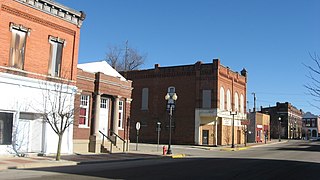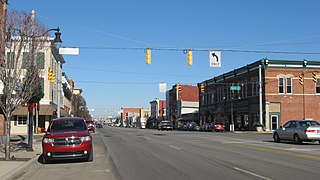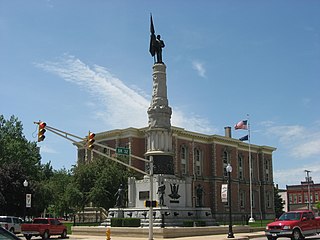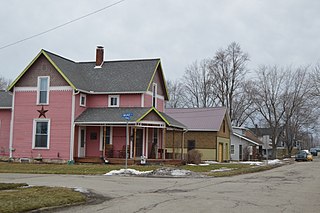
Vernon Historic District is a national historic district located in Vernon and Vernon Township, Jennings County, Indiana. It encompasses 42 contributing buildings and 3 contributing sites in Vernon. The district largely developed between about 1830 and 1900, and includes notable examples of Italianate, Greek Revival, and Federal style architecture. Notable contributing resources include the Jennings County Courthouse (1859), American House tavern, "Rat Row" apartments, Jacob Clinton House (1834), nures drug store (1853),(odd fellows lodge)(1853),Judge Hickman New House (1832), John Bassnett House (1844), Gen. Robert S. Foster House (1840), Methodist Church (1817), Vernon Presbyterian Church (1832), Baptist Church (1871), a stone arch (1832), Tunnel Mill site, and Vinegar Mill site.

Courthouse Historic District is a national historic district located at Logansport, Cass County, Indiana. The district encompasses 79 contributing buildings and one contributing site in the central business district of Logansport. It has a mix of institutional, governmental, and commercial buildings and notable examples of Late Victorian and Romanesque Revival style architecture. Notable contributing resources include the Masonic Hall (1896), Elks Lodge No. 66 (1907), Douglass Building, McCaffey Building, Logansport-Cass County Public Library (1942), The State Theater, United States Post Office (1925), Bank Building, and Watts Building (1901).

Sheridan Downtown Commercial Historic District is a national historic district located at Sheridan, Hamilton County, Indiana. It encompasses 38 contributing buildings and 1 contributing structure in the central business district of Sheridan. It developed between about 1880 and 1939, and includes notable examples of Italianate and Romanesque Revival style architecture. Notable buildings include the H.J. Thistlethwaite Building (1886), Carnegie library, First Christian Church (1910-1911), Higbee Buggy Company, American State Bank (1914), Stanley Brothers Building, Slliot's Drugstore, Indiana Telephone Company building, and U.S. Post Office (1939-1940).

Redkey Historic District is a national historic district located at Redkey, Jay County, Indiana. It encompasses 25 contributing buildings in the central business district of Redkey. The district developed between about 1888 and 1935, and includes notable examples of Italianate, Romanesque Revival, and Classical Revival style architecture. Notable buildings include the City Building (1905), Appenseller's Department Store (1906), K of P Building (1911), Farmers and Merchants First National Bank Building, Masonic Lodge, IOOF Building, Brown-Ellis Block (1888), and Cultice-Mann Block (1891).

Portland Commercial Historic District is a national historic district located at Portland, Jay County, Indiana. It encompasses 58 contributing buildings, 1 contributing structure, and 1 contributing object in the central business district of Portland. The district developed between about 1870 and 1945, and includes notable examples of Italianate, Romanesque Revival, Classical Revival, and Early Commercial style architecture. Located in the district is the separately listed Jay County Courthouse. Other notable contributing resources include the U.S. Post Office (1914) designed by the Office of the Supervising Architect under Oscar Wenderoth, Portland Fire Station #1 (1929), Citizens Bank, FOE Eagles Lodge (1883), Johnson Building, Stevens Building (1910), Walnut Street Church of Christ (1913), and South Meridian Street Bridge (1914).

State Street Historic District is a national historic district located at North Vernon, Jennings County, Indiana. It encompasses 75 contributing buildings and 4 contributing structures in a predominantly residential of North Vernon. The district developed between about 1852 and 1950, and includes notable examples of Queen Anne and Bungalow / American Craftsman style architecture. Notable contributing buildings include the First Baptist Church (1905), First Presbyterian Church (1871), Olcott House, McGannon-Olcott House, Charles Watchell House, Frank Little House, Tripp / Verbarg House, and Joseph C. Cone House.

Walnut Street Historic District is a national historic district located at North Vernon, Jennings County, Indiana. It encompasses 17 contributing buildings in a predominantly residential of North Vernon. The district developed between about 1880 and 1950, and includes notable examples of Late Victorian and Bungalow / American Craftsman style architecture. Notable contributing buildings include the Platter House (1907), Charles Platter House, Frank Platter House, Gumble House, and John Cope House.
Mitchell Downtown Historic District is a national historic district located at Mitchell, Lawrence County, Indiana.

Plymouth Downtown Historic District is a national historic district located in Plymouth, Marshall County, Indiana, United States. The district encompasses 47 contributing buildings and one contributing structure in the central business district of Plymouth. It developed between about 1870 and 1940, and includes examples of Italianate, Romanesque Revival, and Colonial Revival style architecture. Located in the district is the separately listed Plymouth Fire Station. Other notable buildings include the Montgomery Ward Building (1929), Metsker Block, Rentschler Building (1910), Early Plymouth Post Office (1884), First National Bank-Plymouth City Hall, Packard Bank Block (1879), Simons Building (1895), Wheeler Block, Bank Block, Bank Block-Masonic Temple (1901), Plymouth Post Office (1935), and Plymouth Motor Sales (1929).

Ellettsville Downtown Historic District is a national historic district located at Ellettsville, Monroe County, Indiana. The district encompasses 50 contributing buildings in the central business district and surrounding residential sections of Ellettsville. It developed between about 1840 and 1953, and includes notable examples of Queen Anne, Early Commercial, Gothic Revival, and Bungalow/American Craftsman style architecture. Notable buildings include the Robert Stimson House, May Presley House, Bradford House, George W. Fletcher House, Wickens House (1909), Capt. Gilbert Perry House, I.O.O.F. Building, Town Hall (1927), Masonic Building (1895), Knights of Pythias Building, First United Methodist Church (1900), and First Baptist Church (1909).

Kendallville Downtown Historic District is a national historic district located at Kendallville, Noble County, Indiana. The district encompasses 45 contributing buildings in the central business district of Kendallville. It developed between about 1863 and 1940, and includes notable examples of Italianate, Queen Anne, Romanesque Revival, Classical Revival, and Bungalow / American Craftsman style architecture. Located in the district is the separately listed Iddings-Gilbert-Leader-Anderson Block. Other notable buildings include the City Hall (1914), Diggins Building (1892), Masonic Hall Building, and Bernhalter Building.
Mount Vernon Downtown Historic District is a national historic district located at Mount Vernon, Posey County, Indiana. The district encompasses 39 contributing buildings, 2 contributing sites, 1 contributing structure, and 2 contributing objects in the central business district of Mount Vernon. It developed between about 1850 and 1953, and includes notable examples of Italianate, Queen Anne, Romanesque Revival, and Classical Revival style architecture. Located in the district is the separately listed Posey County Courthouse Square. Other notable contributing resources include the McFadin Cemetery, Sherburne Park, the Armory (1922), the Alexandrian (Carnegie) Library (1905), City Hall (1893), Fogas Building (1880), Eagles Home (1917), Palace Soda Shop, Memorial Coliseum (1925), and the Opera House (1879).

Welborn Historic District is a national historic district located at Mount Vernon, Posey County, Indiana. The district encompasses 154 contributing buildings and 5 contributing structures in a predominantly residential section of Mount Vernon laid out by Jesse Welborn between 1822 and 1826. It developed between about 1840 and 1942, and includes notable examples of Greek Revival, Gothic Revival, Italianate, Romanesque Revival, and Colonial Revival style architecture. Notable contributing buildings include the Gov. Alvin P. Hovey House, Edward Sullivan House (1860), C.P. Klein House Johnson-Rosenbaum House (1905), St. Matthew's Catholic Church (1880), First Presbyterian Church (1872), Trinity Evangelical Church (1883), St. John's Episcopal Church (1892), Mount Vernon Post Office (1931).

Farmland Downtown Historic District is a national historic district located at Farmland, Randolph County, Indiana.

Winchester Courthouse Square Historic District is a national historic district located at Winchester, Randolph County, Indiana. The district encompasses 52 contributing buildings and 10 contributing structures in the central business district of Winchester. The district developed between about 1875 and 1950 and includes notable examples of Italianate, Romanesque Revival, and Classical Revival style architecture. Notable buildings include the Randolph County Courthouse (1875), U.S. Post Office (1932), I.O.O.F. Hall, Winchester Community Library (1906), Masonic Lodge, Randolph Hotel, David Building (1927), and W.E. Miller Department Store (1883). Notable structures include the "Spirit of the Doughboy" monument (1928), Lamp of Freedom, Soldiers and Sailors monument (1892), and Laredo Taft Marker.

Ellsworth Historic District, also known as Ellsworth Addition, is a national historic district located at Lafayette, Tippecanoe County, Indiana. The district encompasses 144 contributing buildings, 1 contributing site, and 4 contributing structures in a predominantly residential section of Lafayette. It developed between about 1844 and 1936 and includes representative examples of Italianate, Second Empire, Queen Anne, and Bungalow / American Craftsman style architecture. Located in the district are the separately listed Falley Home, Moses Fowler House, and Temple Israel. Other notable buildings include the Second Presbyterian Church (1894-1895), Alexander House, Ball Brothers House, Falley Townhouse, Home Block, Annie Fowler House, and Duplex Townhouse.

Perrin Historic District is a national historic district located at Lafayette, Tippecanoe County, Indiana. The district encompasses 173 contributing buildings and 2 contributing structures in a predominantly residential section of Lafayette. It developed between about 1869 and 1923 and includes representative examples of Italianate, Queen Anne, Colonial Revival, Stick Style / Eastlake movement, and Bungalow / American Craftsman style architecture. Notable contributing buildings include the James Perrin House, John Heinmiller House, James H. Cable House, Adam Herzog House (1878), Coleman-Gude House (1875), Frank Bernhardt House (1873), August Fisher Cottage, John Beck House (1887), an William H. Sarles Bungalow (1923).

Clinton Downtown Historic District is a national historic district located at Clinton, Vermillion County, Indiana. The district encompasses 46 contributing buildings, 1 contributing site, and 1 contributing object in the central business district of Clinton. It developed between about 1880 and 1935 and includes representative examples of Italianate, Romanesque Revival, and Bungalow / American Craftsman style architecture. Notable contributing resources include the C. & E. I Passenger Station, Bogart Park and Claude Matthews bust / memorial, Scott-Martin Block (1907), H.H. Wisehart Building (1915), Mark W. Lyday Building, Ford Agency Building, and C. & E. I Freight Depot (1912).

LaFontaine Historic District is a national historic district located at La Fontaine, Wabash County, Indiana. It encompasses 56 contributing buildings and 4 contributing structures in the central business district and surrounding residential sections of La Fontaine. It developed between about 1848 and 1930, and includes representative examples of Gothic Revival, Italianate, Queen Anne, Romanesque Revival, Classical Revival, and Bungalow / American Craftsman style architecture.

Cumberland Historic District is a national historic district located at Cumberland, Indiana. It encompasses 91 contributing buildings in the Cumberland section of Indianapolis. The district developed between about 1831 and 1950, and includes representative examples of Folk Victorian and Bungalow / American Craftsman style architecture. Notable contributing resources include the Cumberland Bank (1907), Masonic Lodge, Miller's Lunch, and First Baptist Church (1912-1913).






















